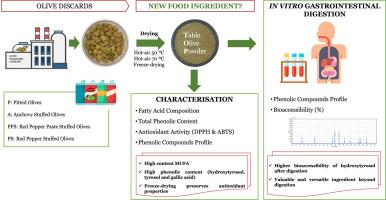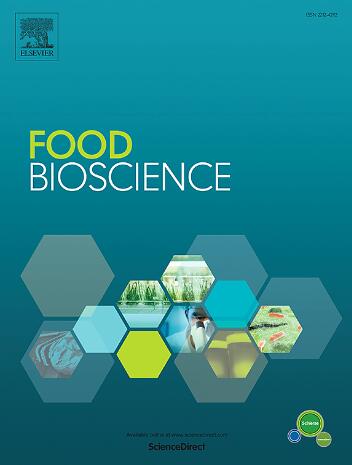Valorisation of table olive discards: bioactive composition and bioaccessibility of a novel functional ingredient
IF 5.9
1区 农林科学
Q1 FOOD SCIENCE & TECHNOLOGY
引用次数: 0
Abstract
The table olive production industry generates considerable volumes of by-products every year, mainly olives that do not meet established quality standards and are withdrawn from commercial channels despite having nutritionally desirable constituents. This work aims to characterise the fatty acid profile and bioactive compounds of new ingredients obtained from table olive discards, namely table olive powders, and to determine their antioxidant properties and the bioaccessibility of their phenolic fraction. The results reveal that the stuffing ingredients and the drying process do not affect the obtained product's fatty acid profile, and all the samples are high in oleic (68.25 %–72.43 %), palmitic (16.34 %–18.42 %) and linoleic (4.42 %–6.95 %) acids. Hot-air drying treatment affects samples' contents of phenolic compounds and samples' antioxidant properties, which makes freeze-drying (FD) extremely suitable for obtaining high-antioxidant powder. Nevertheless, the total phenol content of all table olive powders (TOPs) evaluated was high, with values ranging from 5933.3 to 8141.9 mg GAE/kg of dry weight (DW). After in vitro digestion, hydroxytyrosol (HT), recognised as health-promoting agent, presents the highest bioaccessibility, with values exceeding 100 %. This finding suggests that the digestive process may release antioxidant compounds from their precursor forms, thereby enhancing the functionality of TOPs. This research has shown that table olive discards can be a valuable source of bioactive compounds, exhibiting considerable potential for substituting conventional chemical additives, such as antioxidants, and for the innovation of novel ingredients in new formulations intended for human consumption.

食用橄榄废料的增值:一种新型功能成分的生物活性成分和生物可及性
食用橄榄生产行业每年产生相当数量的副产品,主要是不符合既定质量标准的橄榄,尽管含有有益的营养成分,但仍从商业渠道撤出。这项工作的目的是表征从食用橄榄废料中获得的新成分的脂肪酸谱和生物活性化合物,即食用橄榄粉,并确定它们的抗氧化性能和它们的酚类部分的生物可及性。结果表明,填料成分和干燥工艺对所得产品的脂肪酸谱无明显影响,油酸(68.25% ~ 72.43%)、棕榈酸(16.34% ~ 18.42%)和亚油酸(4.42% ~ 6.95%)含量均较高。热风干燥处理会影响样品中酚类化合物的含量和样品的抗氧化性能,这使得冷冻干燥(FD)非常适合获得高抗氧化性的粉末。然而,所有食用橄榄粉(TOPs)的总酚含量都很高,在5933.3 ~ 8141.9 mg GAE/kg干重(DW)之间。体外消化后,羟基酪醇(hydroxytyrosol, HT)的生物可及性最高,可达100%以上。这一发现表明,消化过程可能从其前体形式释放抗氧化化合物,从而增强TOPs的功能。这项研究表明,餐桌上的橄榄废料可能是生物活性化合物的宝贵来源,在替代传统化学添加剂(如抗氧化剂)和在供人类食用的新配方中创新新成分方面显示出相当大的潜力。
本文章由计算机程序翻译,如有差异,请以英文原文为准。
求助全文
约1分钟内获得全文
求助全文
来源期刊

Food Bioscience
Biochemistry, Genetics and Molecular Biology-Biochemistry
CiteScore
6.40
自引率
5.80%
发文量
671
审稿时长
27 days
期刊介绍:
Food Bioscience is a peer-reviewed journal that aims to provide a forum for recent developments in the field of bio-related food research. The journal focuses on both fundamental and applied research worldwide, with special attention to ethnic and cultural aspects of food bioresearch.
 求助内容:
求助内容: 应助结果提醒方式:
应助结果提醒方式:


